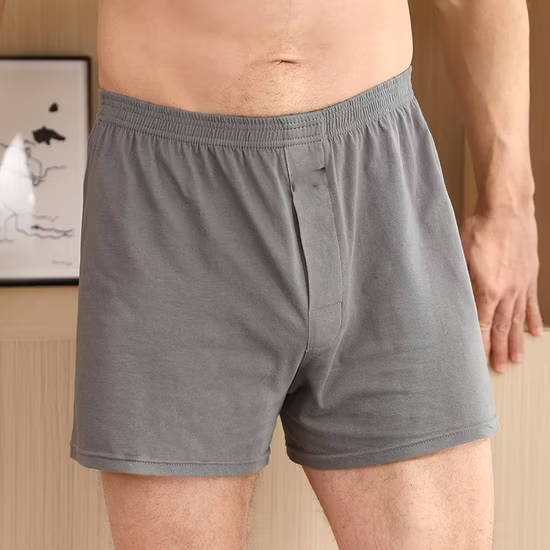In the journey to parenthood, many couples focus on timing, health, and lifestyle—yet few consider the role of something as simple as underwear. For men, the type of underwear worn daily might seem like a matter of comfort or style, but growing research suggests it could play a surprising role in fertility.
Tight-fitting underwear, like briefs and skinny boxer briefs, may be doing more harm than good by increasing scrotal temperature and interfering with optimal sperm production. As male infertility becomes a more openly discussed topic, it’s time to ask: Could your favorite pair of snug undies be affecting your chances of becoming a father?
Recommended: Best Underwear After a Vasectomy: Top 5 Types
In this article, we’ll explore the science behind this theory, break down the latest research, and share practical tips to help you make underwear choices that support—not sabotage—your reproductive health.
Understanding the Link Between Underwear and Fertility
Male fertility depends heavily on healthy sperm production, and one of the most overlooked yet critical factors influencing this is temperature regulation. The testes are located outside the body in the scrotum for a specific reason: they need to stay slightly cooler than the body’s core temperature to produce healthy sperm. Even a small rise in scrotal temperature can interfere with this process.

This is where tight underwear comes into play. Tight-fitting underwear presses the testes closer to the body, trapping heat and reducing air circulation. Over time, this heat buildup can create an environment that’s less than ideal for sperm development, potentially lowering sperm count and motility (how well sperm move).
Several studies support this concern. For instance, a study published in Human Reproduction found that men who wore boxers had significantly higher sperm concentrations than those who wore tighter styles. While tight underwear alone may not cause infertility, it can contribute to a combination of factors that reduce fertility potential—especially when paired with other lifestyle risks like poor diet, smoking, or excessive heat exposure from laptops or hot tubs.
Recommended: Does Testosterone Replacement Cause Infertility?
In short, your underwear choice might seem trivial, but for men trying to conceive, it could be an important piece of the fertility puzzle.
Why Temperature Matters for Sperm Health
Temperature might not be the first thing that comes to mind when thinking about fertility, but for men, it’s one of the most important factors. The process of sperm production—known as spermatogenesis—requires a very specific environment to function correctly. That environment includes a temperature that’s slightly cooler than normal body temperature.
The testes are located in the scrotum, which hangs outside the body, for this exact reason. This natural “cooling system” keeps them about 2–4°C (or roughly 3.6–7.2°F) cooler than the body’s core. When that balance is disrupted—say, by wearing tight underwear, sitting with a laptop on your lap for long periods, or spending a lot of time in hot tubs—it can lead to heat stress in the testes.
Why is this a problem?
Because heat impairs the enzymes and hormones needed to produce healthy sperm. Studies have shown that when testicular temperature increases, sperm count, quality, and motility can decrease significantly. Not only does this affect the ability of sperm to reach and fertilize an egg, but it can also lead to a higher number of abnormally shaped sperm, which further reduces fertility chances.
The effects of heat on sperm aren’t always permanent, but prolonged exposure can make recovery more difficult. That’s why it’s important to recognize how everyday habits, including your choice of underwear, could be quietly undermining your fertility.
Tight vs. Loose: Comparing Underwear Types
When it comes to male fertility, the debate between tight vs. loose underwear is more than just a matter of personal style—it’s a question of reproductive health. While many men choose underwear based on comfort, support, or aesthetics, fertility experts suggest that what you wear down there may influence your chances of becoming a dad.
Recommended: Best Chinese Herbs For Erectile Dysfunction
Tight Underwear (e.g., Briefs, Boxer Briefs, Trunks)
Tight-fitting underwear tends to hold the testes closer to the body, limiting airflow and raising scrotal temperature. As discussed earlier, elevated temperatures can negatively impact sperm production, reducing sperm count and motility over time. Compression-style underwear, often worn for sports or a sleek fit, may also restrict blood flow and increase pressure in the groin area, which isn’t ideal for long-term testicular health.
Loose Underwear (e.g., Boxers, Loose Cotton Shorts)
Loose underwear allows more air circulation and space for the testes to hang naturally away from the body, helping to maintain the lower temperature needed for healthy sperm development. Several studies, including a 2018 Harvard study, have shown that men who wear looser underwear typically have higher sperm concentrations and better sperm quality compared to those who wear tight styles.

Is One Type Always Better?
Not necessarily. If you’re not actively trying to conceive and have no known fertility issues, tight underwear might not cause serious harm. However, for men looking to optimize sperm health—especially those dealing with infertility—it’s worth considering a switch to looser-fitting options.
Also, fabric matters: breathable, natural materials like cotton help wick away sweat and reduce overheating, while synthetic fabrics may trap moisture and heat.
Recommended: Best Dark Chocolate For Prostate Health
Signs Your Underwear Might Be Too Tight
Wearing tight underwear occasionally isn’t a crime—but if it’s part of your daily routine, your body might already be sending subtle warnings. While tight underwear can provide support and style, it can also lead to discomfort, circulation issues, and, over time, even affect your reproductive health. The key is knowing when “snug” becomes too tight.
Here are some signs your underwear might be doing more harm than good:
1. Frequent Groin Discomfort or Chafing
If you regularly experience itching, redness, or irritation around your thighs, inner groin, or waistband, your underwear could be too tight or made from a non-breathable material. This friction can also lead to rashes or fungal infections.
2. Restricted Movement
Good underwear should move with you, not hold you hostage. If you notice that walking, sitting, or bending causes discomfort, or if the elastic digs into your skin, you’re likely wearing a size too small.
3. Visible Marks or Indentations
When you remove your underwear, do you see deep lines or red marks around your waist or thighs? This is a strong sign that your underwear is compressing your body too tightly—possibly interfering with blood flow and air circulation.
4. Sweating or Overheating
Tight underwear made from synthetic fabrics traps heat and moisture, especially in warm climates. Excessive sweating in the groin area not only increases testicular temperature but can also create a breeding ground for bacteria and yeast.
5. Lowered Sperm Health (If Tested)
If you’ve undergone fertility testing and noticed issues like low sperm count or poor motility, tight underwear could be one of the contributing lifestyle factors. It’s not always the main cause, but it’s something worth changing to support recovery.
Recommended: How to Increase Sperm Volume Overnight
Tips for Choosing Fertility-Friendly Underwear
If you’re trying to conceive or simply want to support your reproductive health, your underwear drawer deserves a second look. Choosing the right underwear can help maintain optimal scrotal temperature, promote comfort, and avoid unnecessary pressure on the testicles. Here’s how to make smart, fertility-friendly choices:
1. Go for Loose-Fitting Styles
Choose boxers or loose cotton shorts that allow your testicles to hang freely and breathe. These styles reduce heat buildup and minimize pressure, making them a great option for maintaining sperm health.
2. Prioritize Breathable Fabrics
Natural materials like 100% cotton or moisture-wicking bamboo fabric are best for ventilation. They help absorb sweat, reduce friction, and prevent heat from building up. Avoid synthetic fabrics like polyester or nylon for everyday wear.
3. Size Matters—Pick the Right Fit
Too-tight underwear, even in the right style, can still cause issues. Make sure the waistband doesn’t dig in, the leg holes aren’t cutting off circulation, and your genitals aren’t feeling squished. Your underwear should support you—not squeeze you.
4. Avoid Compression Styles (Unless Necessary)
Compression shorts or tight athletic underwear may be needed during sports, but don’t make them your daily go-to. Limit their use to workouts or short durations and switch back to looser styles afterward.
Recommended: Will Testosterone Therapy Help with Erectile Dysfunction?
5. Rotate and Replace Regularly
Old, stretched-out underwear can lose elasticity and become less supportive, while worn-down synthetic blends may trap more heat. Keep your collection fresh, clean, and in good shape.
6. Consider Sleeping Commando
Letting your body breathe at night can help lower scrotal temperature and give your reproductive system a break. Sleeping without underwear—or in loose-fitting sleepwear—can be a small but beneficial habit for fertility.

Is the Effect of Tight Underwear Permanent?
The good news for most men is that the effects of wearing tight underwear are usually not permanent—but that depends on how long and how severely your body has been exposed to heat and pressure.
Sperm production is a continuous cycle, and it takes about 64 to 72 days for new sperm to fully develop. This means that if tight underwear has negatively impacted your sperm count or quality, switching to looser, breathable underwear and adopting fertility-friendly habits can often lead to recovery within a few months.
Recommended: Is Lack of Sleep Affecting My Testosterone Levels?
However, here are a few important considerations:
Reversible Effects
- If reduced sperm count or motility is caused primarily by increased testicular temperature from tight underwear, improvements are likely once scrotal temperature returns to normal.
- Some men notice better sperm quality after just 3–6 months of lifestyle adjustments, including changes in underwear, diet, and stress levels.
When Damage Might Be Long-Term
- Prolonged exposure to excessive heat, chronic pressure, or underlying medical issues may lead to long-term or irreversible damage, particularly if there is testicular atrophy (shrinking) or hormonal imbalance.
- If tight underwear is combined with other harmful habits (e.g., smoking, heavy alcohol use, or exposure to toxins), the recovery may be slower or incomplete.
Consult a Fertility Specialist
If you’ve been trying to conceive for a while with no success, it’s always a good idea to get a semen analysis. This can help determine whether tight underwear—or something else—is contributing to the issue, and what steps you can take to improve your reproductive health.
Conclusion
While tight underwear might seem like a harmless wardrobe choice, growing evidence suggests it could have a meaningful impact on male fertility—especially when combined with other lifestyle factors. Elevated testicular temperatures caused by snug-fitting underwear can interfere with sperm production, potentially reducing sperm count, motility, and overall quality.
The good news? In most cases, these effects are not permanent. With simple changes like switching to looser, breathable underwear, avoiding prolonged heat exposure, and maintaining healthy habits, many men can significantly improve their reproductive health within just a few months.
Fertility isn’t just about the big, obvious changes—it’s also shaped by small, everyday decisions. So if you’re trying to conceive or want to safeguard your long-term reproductive health, your underwear drawer might be a smart place to start.
